A shade tree is a large tree whose primary role is to provide shade in the surrounding environment due to its spreading canopy and crown, where it may give shelter from sunlight in the heat of the summer for people who seek recreational needs in urban parks and house yards, and thus, also protecting them from the sun’s harmful UV rays and sunburns. Shade trees often have large or densely packed leaves, allowing little or no light through. Shade trees are generally deciduous, so this function is greatly reduced in winter, however sunlight is often more welcome during the winter months.
The right shade tree can make a dramatic statement in your landscape. It can also increase your property value and provide a cool spot to relax on hot summer days. You have numerous options when it comes to shade trees, but it takes careful thought and planning to choose just the right tree for your yard. Consider the appearance, size and planting requirements before selecting a shade tree to add to your outdoor space. Here are some of the fastest growing shade trees to try.
- Northern red oak
- Quaking Aspen
- Paper Birch
- Red Sunset Maple
- Hackberry
- Pin Oak
- River Birch
- Northern Catalpa
- American Sweetgum
- Tulip tree
- Dawn Redwood
- Weeping Willow
- Live Oak
- London Planetree
- American Linden
- Bur Oak
- Japanese Zelkova
- Tipu tree
- Weeping dogwood
- Hybrid crapemyrtle
- Oshu Shidare Japanese maple
- Jacaranda mimosifolia
- Himalayan white pine
Northern Red Oak
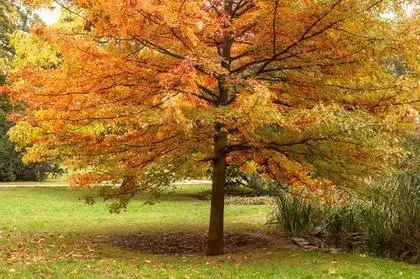
Northern red oak is a large, deciduous tree that can reach heights of up to 70 feet, with an upright, somewhat irregular habit, golden or brown colored autumn foliage, and a wide trunk.The bark is smooth on young trees but as it ages, wide, flat-topped ridges and shallow furrows develop. The tree is unique, and it doesn’t compare to any Red Oak class of trees. It also grows fast, and it has an open canopy which enables it to grow tall. Red Oaks are stately trees with some of the most fantastic shade and fall foliage you will ever see.
Quaking Aspens
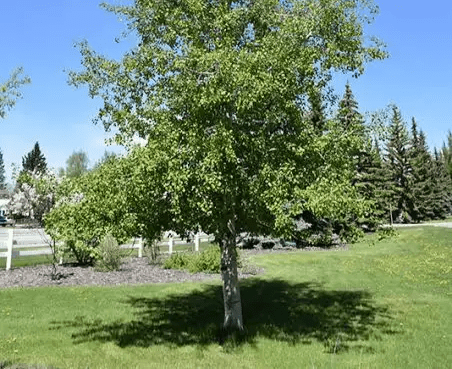
Quaking aspens, also called trembling aspens, are named for their leaves a name that refers to how its leaves tremble at the slightest breeze. It is a small to medium-sized tree with an open and rounded crown. Its bark is thin with a white to gray-green color that feels almost smooth with black areas around the base of limbs. Quaking aspen isn’t the best tree for every landscape, but can work effectively as a shade tree. To grow a single quaking aspen as a specimen plant or shade tree, you must continually remove any new plants that pop up from the root system to avoid growing unwanted trees.
Paper Birch
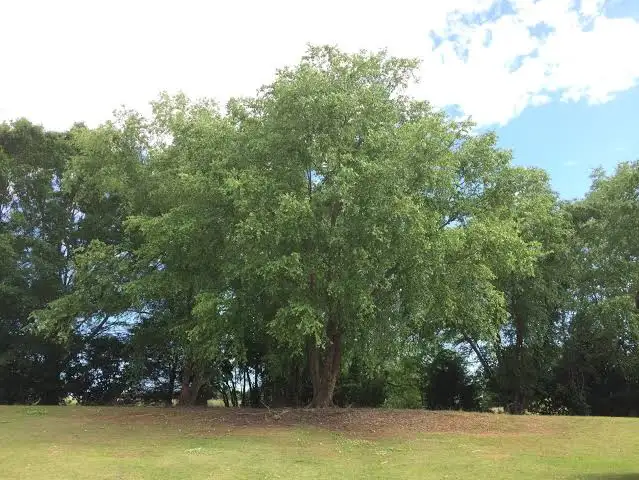
The paper birch tree is a fast-growing but short-lived tree that often develops multiple trunks as the plant matures. The most distinctive characteristic of this deciduous tree is the peeling bark, which contrasts sharply against the green leaves that turn bright yellow in fall. Add delicate shade to your home’s landscaping by planting a paper birch tree.
Also Read: Fast Growing Trees From Around The World
Hackberry

The hackberry is also known for its distinctive bark surface, which has a corky texture (with warts at the base) and is often described as stucco-like. Its attractive serrated leaves range from dull green to glossy, and have unequal bases and tapered ends. In the fall months, the leaves will turn into a bland yellowish color before falling off. Hackberry is commonly found on roadsides and in forested areas. It will make a great shade tree for any acreage or landscape setting. It is a very fast growing tree, which means it will drop small branches on windy days and more in storms, so plant it where the branches will not affect your day-to-day activities.
Red Sunset Maple
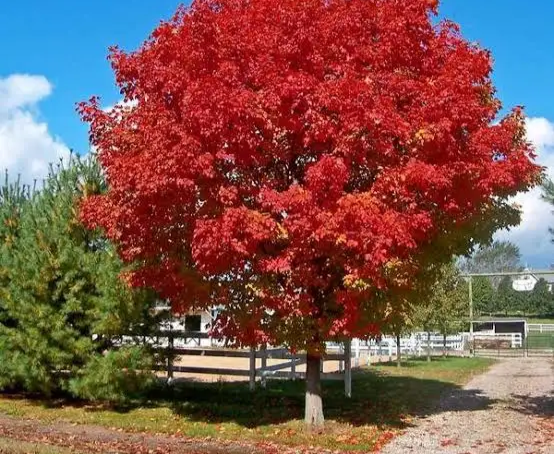
Red Sunset is a red maple cultivar with superior fall color and good branch structure. Winter buds, clusters of small winter spring flowers, leaf stems, twigs, and winged summer fruits are all reddish colored. Red Sunset are stately trees with some of the most fantastic shade and fall foliage you will ever see. The glossy green leaves persist on the tree turning orange-red to brilliant red in the fall. The mature tree reaches between 30 and 40 feet which make it an important consideration for homeowners with small yards who need assurance that a tree is not going to overwhelm their properties.
Pin Oak
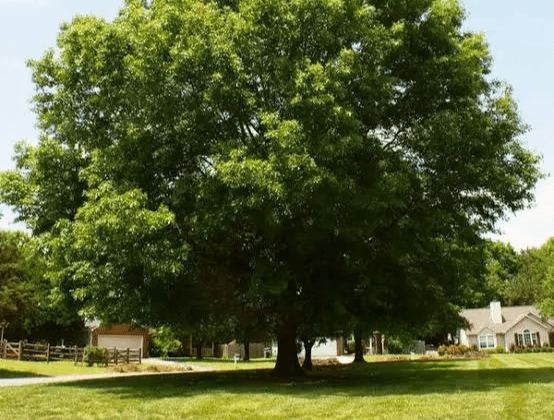
Pin Oak is a medium-size shade tree, turning from a pyramid form when young to an oval shape as it matures and growing from 60 to 70 feet tall. Its canopy is conical or rounded and can extend as wide as the tree is tall. The tree grows rapidly, more than 24 inches each year. If you grow one as a street tree, you won’t have to wait long for it to provide shade. The uniquely shaped leaves are a beautiful dark green in summer turning to dull scarlet in the autumn. Pin oaks are also known as swamp oaks, because they like moist and even wet soil.
Also Read: Different Types of Hardwood Trees
River Birch

The river birch is a fast-growing deciduous shade tree, usually multi-stemmed, that is very popular in landscape use. It has the beautiful exfoliating bark that is the hallmark of many birches, but it is one of the most adaptable birch species, with better tolerance for poorly drained soils and warm conditions than most species of birch.Young single-trunked trees have an oval to pyramidal habit that matures to a rounded crown. In the wild, river birch grows near the banks of streams and rivers, bottomlands, and floodplains. This is a fast-growing tree that averages about 36 inches of growth per year.
Northern Catalpa

The northern catalpa is a moderately large deciduous tree with white, showy (and fragrant) flowers, massive heart-shaped leaves, and dangling bean-like seed pods that persist through the winter, supported by a massive trunk and twisting branches. This is an exceptionally fast-growing tree when started from seed. You can expect growth of up to 24 inches each year for young trees, then about 1 foot per year for older trees. Northern catalpa is primarily used today as a large ornamental shade tree. It is widely planted in urban areas as a street and lawn tree. Generally, the tree is best suited for large open spaces at least 50 feet from permanent structures or underground features, such as pools or sewer lines.
American sweetgum
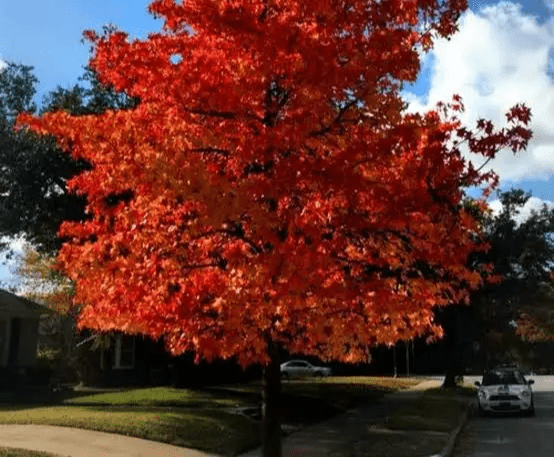
American sweetgum are deciduous trees prized for their mix of brilliant fall colors. American sweetgum can reach 80 feet in height at maturity, with a spread of about 60 feet. It grows like a pyramid during its formative years, but will change into a ring-like canopy as it matures. Its growth rate is moderate to rapid, putting on height at a rate of 1 to 4 feet a year for the first five to 10 years and 12 to 15 inches per year thereafter. The foliage is palmate, like a maple leaf, but more deeply lobed and star shaped. It is glossy green in the spring and summer, turning to vivid red, yellow and even purple in the fall.
Also Read: Different Types of Cypress Trees
Tulip Tree

A fast-growing tree with bright green leaves that resemble tulip flowers in profile and turn golden yellow in fall. Tulip trees are easily identified by their spring flowers and showy leaf shape.The flowers are yellowish-green, with a touch of orange on the outside. When young, this tree tends to have a canopy with an upright pyramidal growth habit, as it ages, the tree becomes columnar or more spreading and open. The branches begin rather far up the straight trunk and are often arranged symmetrically. The tulip tree grows 60 to over 100 feet tall with a spread of about 40 feet. The cultivar “Arnold” grows up to 60 feet tall with a narrow, upright form, magnolia-like flowers and golden yellow fall foliage.
Dawn Redwood

The dawn redwood is a tall tree, reaching heights of over 100 feet in as little as 50 years, with some trees growing as tall as 160 feet. Young trees typically have a pyramid shape, but become more rounded and spread out as they age. The dawn redwood’s soft and stringy bark is brownish-red and winds around the tree’s trunk, giving it a twisted, gnarled appearance.The bright green, feathery leaves turn orange-brown or reddish-brown in the fall. Fast-growing and easily transplanted. Likes full sun and prefers moist, deep, well-drained soils.
Weeping Willow

Weeping willow trees typically grow to anywhere between 30 and 40 feet tall, with similar spreads. The trees have wide, circular crowns, small trunks and elongated, loosely hanging branches. Their elegant branches hang in a clear downward direction, giving rise to the “weeping” part of their name.Weeping willows are fast-growing trees, adding up to 10 feet per year when young, but their average lifespan is a relatively short 30 years. Weeping willow’s stately appearance makes it a dominant tree in many landscapes, and it is commonly grown as a shade tree in backyards and near patios and terraces.
Live Oak

The name “live oak” comes from the fact that the tree retains its green leaves throughout the wintertime, unlike other oaks that tend to go dormant and lose their leaves. Live oak also called southern live oak, is a popular shade tree in the Southeastern United States. Ranging from 65 feet to 85 feet in height, live oaks are large trees with spreading crowns. Standard live oak is buttressed and flared at the base of the dark brown to reddish brown trunk. Narrow to broadly elliptical leaves are shiny dark green on the top, dully grayish green underneath and often stay on the tree throughout the winter until new leaves emerge in spring. These trees are found near entryways in park and commercial and luxury landscape designs.
Also Read: Trees With Beautiful Fall Color (Red, Yellow, Pink)
London Plane Tree
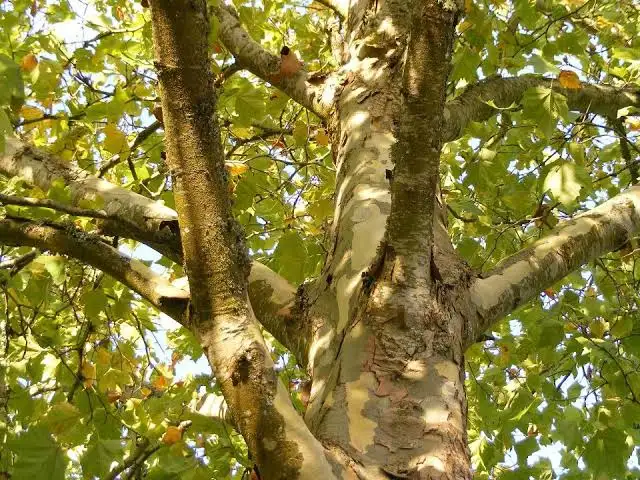
The London plane tree typically resulted from a cross between the Oriental planetree and the American sycamore. A fast-growing tree, the London plane typically gains several feet in height per year. The striking feature of this tree is its brown bark which exfoliates in irregular pieces to reveal a mottled creamy white inner bark. Its green leaves are around four to nine inches wide with three to five lobes, and its fall foliage is a rather plain yellow-brown. Small flowers appear in clusters in the early spring, gradually ripening into fruit balls that turn brown in the fall.
American Linden

The American linden is a large tree at maturity, reaching 50 to 80 feet in height with a spread of 35 to 50 feet. Lindens are valued in for hardiness and adaptability to a variety of soils and environmental conditions, not to mention the visually appealing form. The American linden is pyramidal when young, maturing to an upright, symmetrical, oval canopy with a straight trunk. The lower branches dip toward the ground and then curve upward gently.
Bur Oak
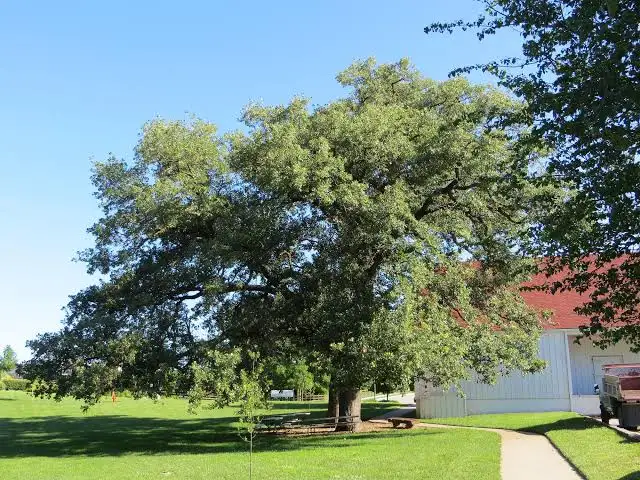
Considered the most majestic of all native oaks, the burl oak usually reaches a height of 60 to 80 feet when fully grown, although some exceptional specimens are well over 100 feet tall. A young tree has a columnar shape, but with increasing age the crown broadens and the entire tree widens to assume a spreading shape. The leaves of the burl oak are between 6 and 12 inches long and have many lobes, with those near the end of each leaf forming the shape of a crown.The acorns have a fringed, mossy scale around the rim of their caps, hence the common name mossy-cup oak.
Also Read: Major Types of Trees With White Bark
Japanese Zelkova
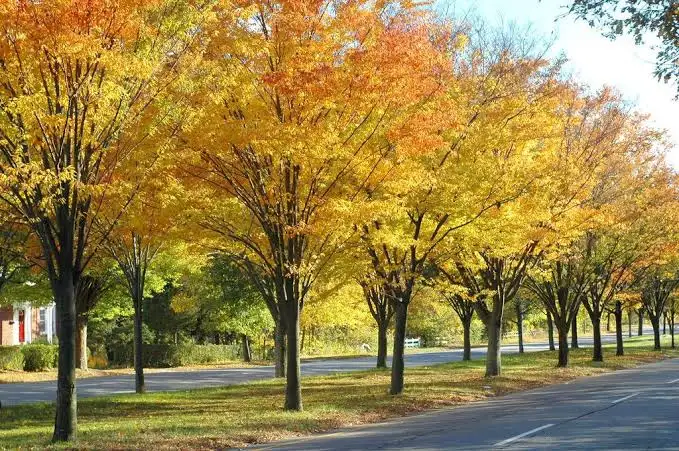
Japanese Zelkova or saw leaf zelkova is a tough urban tree for residential shade and street plantings. It has a spreading, generally upright branching, vase-shaped habit. It grows from 50 to 80 feet high with a canopy from 50 to 75 feet wide. The medium green leaves of the graceful, elegant Japanese Zelkova turn copper, orange, deep red to purplish red or yellow in the fall. As the tree gets older, its gray-brown bark often peels, exposing striking orange patches of inner bark.
Tipu Tree

The tipu tree also called Brazilian rosewood, is an evergreen shade tree that yields small, apricot-yellow blossoms. The tree has rough bark and grows up to 50 feet tall, producing a spreading, flat canopy. The lower branches high on the trunk can be pruned to shape its canopy into the form of an inverted vase or umbrella shape. Its leaves are bright green and smooth. In late spring and summer, large sprays of golden-yellow flowers appear. These are followed by green winged seeds, 50 to 60mm long, that dry to yellowish-brown and remain on the tree all winter and much of spring. They are freely self-seeding.
Jacaranda mimosifolia
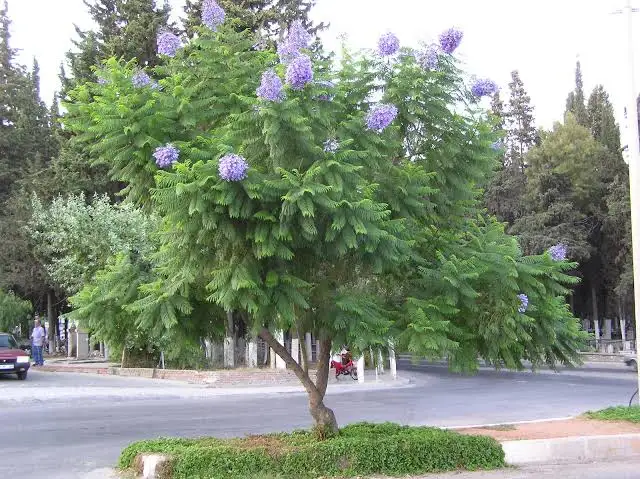
The jacaranda tree is a beautiful tropical tree that produces clusters of fragrant purple panicle-shaped blooms. Jacaranda branches are arched, forming a canopy shaped like an upturned umbrella. The jacaranda tree makes an excellent shade (or street) tree with its fern-like leaves that can grow up to 20 inches in length. It is a fast-growing tree in a tropical environment, gaining about ten feet a year in its first years of life. Its growth rate varies depending on where it’s grown, slowing down to a moderate growth rate outside its ideal tropical environment.
Further References
- Fast Growing Shade Trees: https://arbordayblog.org/landscapedesign/12-fast-growing-shade-trees/
- Beautiful Shade Trees For Your Yard: https://www.bhg.com/gardening/trees-shrubs-vines/trees/shade-trees/
- Types of Fast Growing Shade Trees: https://www.thespruce.com/fast-growing-shade-trees-zones-5-10-2132684
- Fast Growing Trees For Shade: https://www.homesandgardens.com/advice/best-trees-for-shade